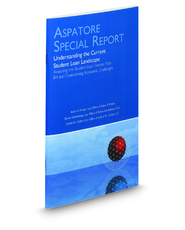LEGAL


Understanding the Current Student Loan Landscape provides feedback from some of the nation's leading legal minds on the student loan interest rate bill and the financial environment that surrounds the higher education industry. These experts discuss the specifics of the new law, give insight into how they advise clients on their options for repaying student loans, and mention valuable resources for staying up-to-date on these matters.
As more and more students are funding their education through loans, a key concern of borrowers is the interest rate on those loans. In an effort to address this, President Obama signed a student loan interest rate bill into law on August 9, 2013, essentially tying interest rates to financial markets. While this bill provides some relief for students, it also raises important questions. What are the advantages and disadvantages of this new law? What long-term impact will the law have on the education industry? How will this ultimately impact the US economy as a whole? How will it affect repayment? Beyond the passage of this bill, rising rates of student loan debt and default are driving the need for potential solutions to the larger issue. What are the necessary qualifications of applying for forbearance or deferment? Are there any risks involved with these options? What are the repercussions of defaulting on federal student loans? On private student loans? What are some useful suggestions for those dealing with student loan creditors, debt collectors, and loan servicers?
This report offers readers an on-the-spot look at this issue as it continues to unfold.
Enter replacement volume, chapter and page numbers separated by commas. For example: Volume 2, Chapter 5, Pages 7, 12-19. Please limit requests to 25 pages or less. If you are located outside the United States or for more than 25 pages please contact Customer Service 1-800-328-4880.